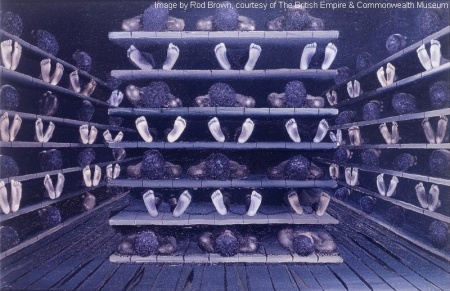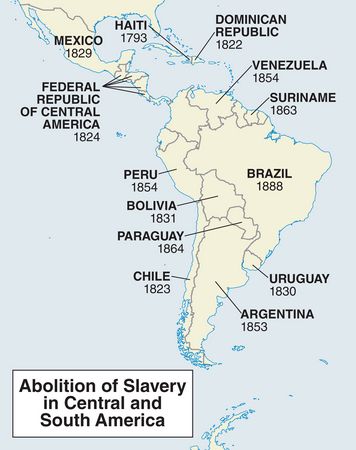
“Plates_W. E. B. Du Bois Data Portraits”
The graphic illustrates not just the location of slave ports in Africa, but the travel of slave ships to the Americas. The darker the hue of black, the more activity in the slave trade their was in that respective location.
Topics on the Page
--Overview
--Background
--Expansion
--Race
--Gender
--Resistance
--Abolition
 The Atlantic Slave Trade: 315 Years. 20,528 Voyages. Millions of Lives
The Atlantic Slave Trade: 315 Years. 20,528 Voyages. Millions of Lives
- A visualization of voyages bringing slaves to Europe and the Americas, year by year
Chains Used in the Slave Trade


- The Clotilda was the last slave ship to reach the United States
- Brought 110 Africans in 1860
- Discovered in Alabama's Mobile River in 2019
 Cross-Links:
Cross-Links:
European Exploration and the Atlantic Slave Trade
Slavery in Colonial North America
AP United States History Period 1: Encounters Between Europeans, Native Americans and Africans
Major slave trading regions of Africa

Background
When the Portuguese first sailed down the Atlantic coast of Africa in the 1430s they were interested in not slaves but gold.
- Ever since Mansa Musa, the king of Mali, made his pilgrimage to Mecca in 1325 with 500 slaves and 100 camels (each carrying gold), the region had become synonymous with such wealth.
There was one major problem: trade from sub-Saharan Africa was controlled by the Islamic Empire which stretched along Africa's northern coast. Muslim trade routes across the Sahara, which had existed for centuries, involved salt, kola, textiles, fish, grain, and slaves.
As the Portuguese extended their influence around the coast, Mauritania, Senagambia (by 1445) and Guinea, they created trading posts.
- Rather than becoming direct competitors to the Muslim merchants, the expanding market opportunities in Europe and the Mediterranean resulted in increased trade across the Sahara.
- In addition, the Portuguese merchants gained access to the interior via the Senegal and Gambia rivers which bisected long-standing trans-Saharan routes.
The Portuguese brought in copper ware, cloth, tools, wine and horses. (Trade goods soon included arms and ammunition.) In exchange, the Portuguese received gold transported from mines of the Akan deposits, pepper (a trade which lasted until Vasco da Gama reached India in 1498), and ivory.
There was a very small market for African slaves as domestic workers in Europe and as workers on the sugar plantations of the Mediterranean. However, the Portuguese found they could make considerable amounts of gold transporting slaves from one trading post to another along the Atlantic coast of Africa. Muslim merchants wanted slaves to be used as porters on the trans-Saharan routes (with a high mortality rate) and sold in the Islamic Empire.
Elmina slave castle, Cape Coast, Ghana

The Portuguese found Muslim merchants entrenched along the African coast as far as the Bight of Benin. The slave coast, as the Bight of Benin was known, was reached by the Portuguese at the start of the 1470s. It was not until they reached the Kongo coast in the 1480s that they outdistanced Muslim trading territory.
The first of the major European trading 'forts', Elmina, was founded on the Gold Coast in 1482. Elmina (originally known as Sao Jorge de Mina) was modeled on the Castello de Sao Jorge, the first of the Portuguese Royal residence in Lisbon. Elmina, which means "the mine," became a major trading center for slaves purchased along the slave rivers of Benin.
Watch these facts about Slavery that you won't learn in school!
The Slave Trade Expands
 The Atlantic Slave Trade in Two Minutes is a time lapse video of every slave voyage from 1560 to 1860
The Atlantic Slave Trade in Two Minutes is a time lapse video of every slave voyage from 1560 to 1860

By the beginning of the colonial era there were forty such forts operating along the coast. Rather than being icons of colonial domination, the forts acted as trading posts - they rarely saw military action - the fortifications were important, however, when arms and ammunition were being stored prior to trade.
For centuries Europeans rendered sugars from beets and other local produce - a labor-intensive effort which yielded mediocre results.
When explorers returned from what is Indonesia today with samples of sugarcane there was an instant market for this superior sweetener. Sugar cane must be grown in the tropics, requires good soils and a large, pliant labor force. The East Indies lacked the latter and was far removed from European markets.
Africa had the needed workers but poor soils. The maritime powers thus began developing sugar plantations in South America and the Caribbean and importing African slaves to do the heavy lifting there.
The demand for slaves in the New World was closely linked to the demand for sugar in the Old World.
What was the racial basis for the Atlantic slave trade?
The long history of slavery, going back to ancient and biblical times, never used racial classification as a basis for the keeping of slaves.
The origins of the eventual race-based slavery as practiced in the Southern United States are cloudy, and subject to much contrasting historical scholarship.
Most historians now believe that slavery as a economic phenomenon preceded slavery's racial basis. "As the staple crop plantation system matured and became entrenched on the North American mainland in the late 17th and early 18th centuries and planters required a large and regular supply of slaves, African laborers became synonymous with large-scale plantation production." - Justin Roberts, Oxford University
For more: Race and the Origins of Plantation Slavery
Spain and Portugal dominated the slave trade in South America while the English and to a lesser extent the Dutch and French controlled most of the the trade in the Caribbean which passed some of its imported human cargo onto North America.
Demand for slave labor grew steadily in the north as tobacco, rice and, later, cotton came into widespread production there.
Slaves eventually came to account for 20% of the population of British North America, a substantial number but far less than proportions on many West Indian islands which have been totally transformed by African cultures.
Conditions for African men, women, and children who were captured and forced overseas were brutal every step of the way. It is estimated that twelve million made the crossing of whom a little over ten million survived. This accounts for the largest forced movement of peoples in world history. As many as 390 captives were shackled below decks in extremely cramped quarters for up to 70 days on the infamous "Middle Passage." Here is more info on those horrific voyages: Life on Board Slave Ships

Women often experienced additional difficulties throughout the passage and while enslaved, including sexual abuse and separate treatment on the plantations.
The Caribbean was known as the "graveyard for slaves" since so many died on the plantations there and had to be replaced by new imports. "Sugar slaves" suffered the highest mortality rates of workers held in bondage anywhere. It is estimated that 800,000 slaves were brought to the Caribbean of whom 300,000 remained.
RESISTANCE
It is important to remember that every single person enslaved and brought to America were human being with emotions, thoughts and beliefs. While these men, women, and children were undoubtedly victims of one of the most atrocious and long standing periods in global history, they were often resilient in fighting against their enslavement and maintaining culture.
Explore here to find accounts of these folks' experiences as well as many accounts of resistance and mutinies.

Here are some ideas & materials for lesson plans about various aspects of the Atlantic Slave Trade, grouped by grade level: The Transatlantic Slave Trade - Education Materials
When did Slavery End in Central and South America? Look Here->

Comments (0)
You don't have permission to comment on this page.